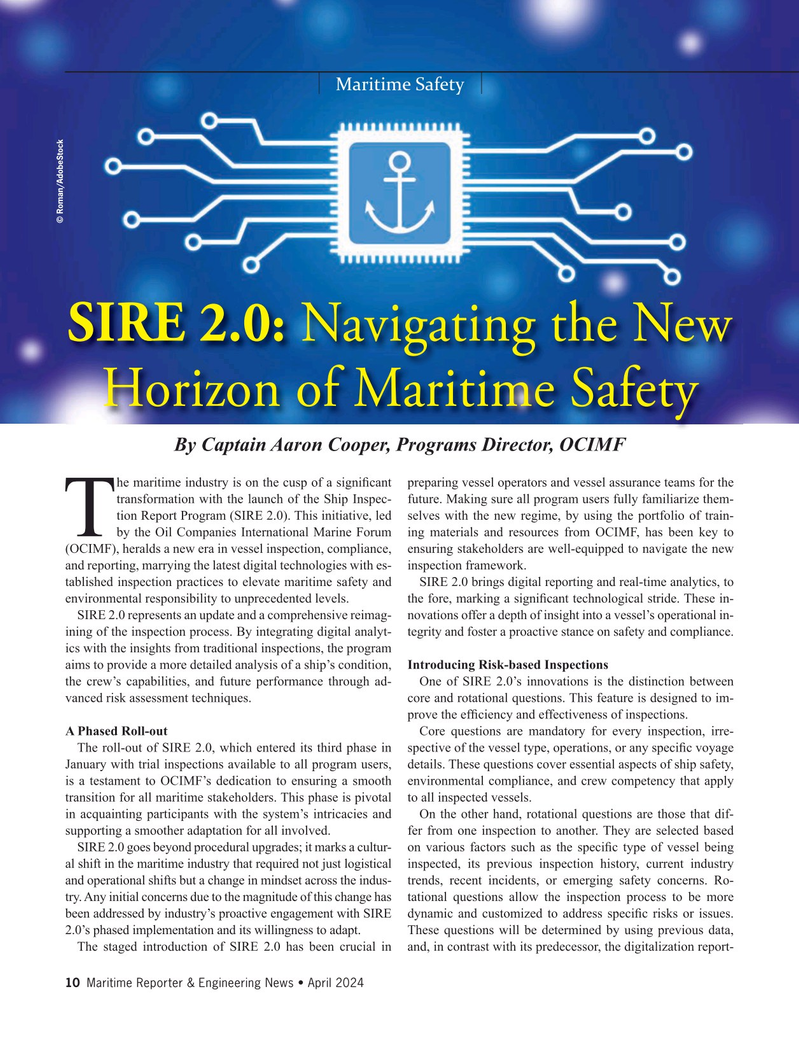
Page 10: of Maritime Reporter Magazine (April 2024)
Read this page in Pdf, Flash or Html5 edition of April 2024 Maritime Reporter Magazine
Maritime Safety © Roman/AdobeStock
SIRE 2.0: Navigating the New
Horizon of Maritime Safety
By Captain Aaron Cooper, Programs Director, OCIMF he maritime industry is on the cusp of a signi? cant preparing vessel operators and vessel assurance teams for the transformation with the launch of the Ship Inspec- future. Making sure all program users fully familiarize them- tion Report Program (SIRE 2.0). This initiative, led selves with the new regime, by using the portfolio of train-
Tby the Oil Companies International Marine Forum ing materials and resources from OCIMF, has been key to (OCIMF), heralds a new era in vessel inspection, compliance, ensuring stakeholders are well-equipped to navigate the new and reporting, marrying the latest digital technologies with es- inspection framework. tablished inspection practices to elevate maritime safety and SIRE 2.0 brings digital reporting and real-time analytics, to environmental responsibility to unprecedented levels. the fore, marking a signi? cant technological stride. These in-
SIRE 2.0 represents an update and a comprehensive reimag- novations offer a depth of insight into a vessel’s operational in- ining of the inspection process. By integrating digital analyt- tegrity and foster a proactive stance on safety and compliance. ics with the insights from traditional inspections, the program aims to provide a more detailed analysis of a ship’s condition, Introducing Risk-based Inspections the crew’s capabilities, and future performance through ad- One of SIRE 2.0’s innovations is the distinction between vanced risk assessment techniques. core and rotational questions. This feature is designed to im- prove the ef? ciency and effectiveness of inspections.
A Phased Roll-out Core questions are mandatory for every inspection, irre-
The roll-out of SIRE 2.0, which entered its third phase in spective of the vessel type, operations, or any speci? c voyage
January with trial inspections available to all program users, details. These questions cover essential aspects of ship safety, is a testament to OCIMF’s dedication to ensuring a smooth environmental compliance, and crew competency that apply transition for all maritime stakeholders. This phase is pivotal to all inspected vessels. in acquainting participants with the system’s intricacies and On the other hand, rotational questions are those that dif- supporting a smoother adaptation for all involved. fer from one inspection to another. They are selected based
SIRE 2.0 goes beyond procedural upgrades; it marks a cultur- on various factors such as the speci? c type of vessel being al shift in the maritime industry that required not just logistical inspected, its previous inspection history, current industry and operational shifts but a change in mindset across the indus- trends, recent incidents, or emerging safety concerns. Ro- try. Any initial concerns due to the magnitude of this change has tational questions allow the inspection process to be more been addressed by industry’s proactive engagement with SIRE dynamic and customized to address speci? c risks or issues. 2.0’s phased implementation and its willingness to adapt. These questions will be determined by using previous data,
The staged introduction of SIRE 2.0 has been crucial in and, in contrast with its predecessor, the digitalization report- 10 Maritime Reporter & Engineering News • April 2024
MR #4 (1-17).indd 10 4/5/2024 8:37:12 AM

 9
9

 11
11
